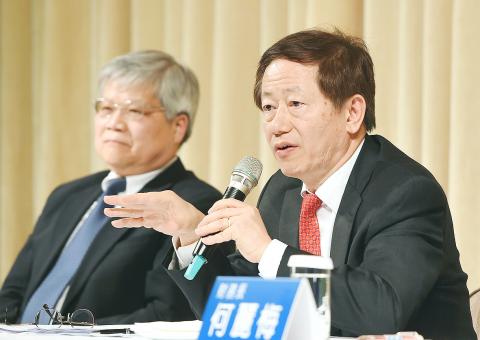Taiwan Semiconductor Manufacturing Co (TSMC, 台積電) yesterday said it was cutting its capital expenditure budget this year by US$1 billion because of disappointing demand for smartphone chips this quarter.
The manufacturer of chips, including for Apple Inc’s iPhone 6, said it plans to spend US$11 billion on advanced technology development this year, down from its previous estimate of US$12 billion.
The revised figure is still higher than Intel Corp’s budget of US$8.7 billion, after the US chip manufacturer cut its proposed capital expenditure by US$1.3 billion on Tuesday.

Photo: Liao Chen-huei, Taipei Times
Hsinchu-based TSMC attributed the cutback to several factors, including boosting capital efficiency, clients’ faster migration to more advanced 16-nanometer (nm) chips from 20nm chips, and slackening demand.
The size of the cut was larger than Credit Suisse analyst Randy Abrams’ estimates of a reduction of “several hundred million [US] dollars.”
That implies Qualcomm Inc — one of TSMC’s biggest customers — lost some orders, as Samsung Electronics Co starts using its own chips in its Galaxy smartphones, Abrams said.
“We expect the impact will be only in 2015,” Abrams said.
TSMC also trimmed its revenue forecast for the global semiconductor industry this year, predicting annual growth of 4 percent from an earlier estimate of 5 percent.
The company also lowered its growth estimates for global foundry revenues to 10 percent from its prior forecast of 12 percent.
Despite a challenging environment, “we will work to achieve double-digit percentage [revenue] growth this year,” TSMC co-chief executive officer Mark Liu (劉德音) said.
Revenue for this quarter is expected to contract by between 6.77 percent and 8 percent to between NT$204 billion and NT$207 billion (US$6.53 billion and US$6.62 billion), compared with NT$222.03 billion last quarter, because inventory correction on the clients’ side could affect demand, Liu said.
“Some of our customers appeared to have been too optimistic about their business outlook, resulting in higher-than-expected inventory levels,” Liu said.
“Some of our mobile customers have recently cut back deliveries because demand did not meet their expectations,” he said.
Lower demand — mostly for handset chips — would lower the chipmaker’s 0.28nm capacity utilization rate to about 80 percent this quarter, co-chief executive Wei Che-chia (魏哲家) said.
As a result, 20nm chips — mostly used for high-end smartphones — would only contribute about 15 percent to the company’s overall revenue this year, down from its previous forecast of 20 percent, Wei said.
However, TSMC expects the slowdown to be short-lived, with growth momentum gathering steam in the second half of the year, as customer demand recovers after inventories return to normal levels at the end of this quarter and new 16nm chips start to contribute to its revenue stream.
The company also reported that net profit surged 65 percent from a year earlier to NT$78.99 billion (US$2.53 billion) last quarter, but declined 1.2 percent from a record profit of NT$79.99 billion the previous quarter.
Commenting on the water shortage problem, TSMC said it would use water trucks to transport water for its factories in Tainan after the government further tightened water restrictions on Wednesday.
The company said that water rationing had not affected its manufacturing operations.

The US dollar was trading at NT$29.7 at 10am today on the Taipei Foreign Exchange, as the New Taiwan dollar gained NT$1.364 from the previous close last week. The NT dollar continued to rise today, after surging 3.07 percent on Friday. After opening at NT$30.91, the NT dollar gained more than NT$1 in just 15 minutes, briefly passing the NT$30 mark. Before the US Department of the Treasury's semi-annual currency report came out, expectations that the NT dollar would keep rising were already building. The NT dollar on Friday closed at NT$31.064, up by NT$0.953 — a 3.07 percent single-day gain. Today,

‘SHORT TERM’: The local currency would likely remain strong in the near term, driven by anticipated US trade pressure, capital inflows and expectations of a US Fed rate cut The US dollar is expected to fall below NT$30 in the near term, as traders anticipate increased pressure from Washington for Taiwan to allow the New Taiwan dollar to appreciate, Cathay United Bank (國泰世華銀行) chief economist Lin Chi-chao (林啟超) said. Following a sharp drop in the greenback against the NT dollar on Friday, Lin told the Central News Agency that the local currency is likely to remain strong in the short term, driven in part by market psychology surrounding anticipated US policy pressure. On Friday, the US dollar fell NT$0.953, or 3.07 percent, closing at NT$31.064 — its lowest level since Jan.

The New Taiwan dollar and Taiwanese stocks surged on signs that trade tensions between the world’s top two economies might start easing and as US tech earnings boosted the outlook of the nation’s semiconductor exports. The NT dollar strengthened as much as 3.8 percent versus the US dollar to 30.815, the biggest intraday gain since January 2011, closing at NT$31.064. The benchmark TAIEX jumped 2.73 percent to outperform the region’s equity gauges. Outlook for global trade improved after China said it is assessing possible trade talks with the US, providing a boost for the nation’s currency and shares. As the NT dollar

The Financial Supervisory Commission (FSC) yesterday met with some of the nation’s largest insurance companies as a skyrocketing New Taiwan dollar piles pressure on their hundreds of billions of dollars in US bond investments. The commission has asked some life insurance firms, among the biggest Asian holders of US debt, to discuss how the rapidly strengthening NT dollar has impacted their operations, people familiar with the matter said. The meeting took place as the NT dollar jumped as much as 5 percent yesterday, its biggest intraday gain in more than three decades. The local currency surged as exporters rushed to